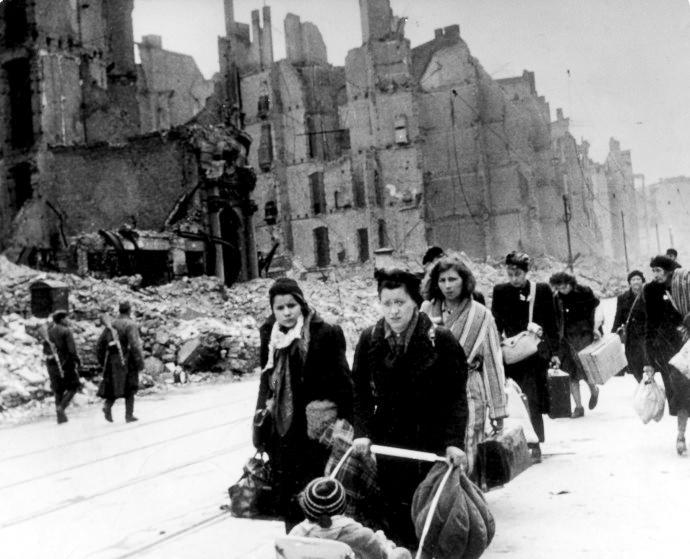
World War II : German Refugees: Internal Refugees

Figure 1.--Countless images of bombed out German cities after the war show endless streams of German refugees, mostly women, children, and the elderly, moving through the rubble. Each had their own story. Given what the Germans had done, there was little sympathy for them. We wonder what they thought about the people being bombed as they watched German newsreels earlier in the War. These people look to be moving out of the enter of a bombed out city, probably Berlin. We have no idea where thry were headed. Notice the two Red Army soldiers on patrol at the left. Given they way they are dressed, it was months after the end of the war. People viewing the ruins believed it would be 30 years if ever before the cities could be rebuilt.
|
|
Initially the success of German arms created refugees in the countries bordering Germany in all directions. east, north, west, and south. As the War progressed, especially after the Soviet Red Army survived the blow of Barabarossa, the Germans themselves began to experience the dislocations they had inflected upon other countries. The first were the people displaced by the Allied strategic bombing campaign. At first the British strategic bombing campaign had little impact, but with the arival of the British Avro Lancaster (1942) and the beginnng of the Around the Clock bombing campaign with the Americans, large numbers of Germans were dehoused and made internal refugees. An excellent civil defense effort limited casualties, but the destruction in the cities began to create increasing numbers of internal refugees. The Red Cross and German welfare organizations cared for these people and found housing and basic necesities for them. The children were evacuated from the cities as part of the KLV program. The War effort meant that many civilians, including the KLV children, were posted far away from home. And after the D-Day break out (August 1944), the strategic bombing campaign resumed with an intensity unknown in history. As a result of the destruction of the Luftwaffe, there was very little limit on the steady stream of bombers flowing out of American and British aircraft plants. American and British bombing strategy differed somewhat, but as most of German indistry and transportation nodes was located within cities, those cities became the primary targets. And as targeting technolgy plants and facilities were tasrgetted, who cities absorbed grevious damage. This emense destruction created a refugee crisis that the German welfare organizations struggled to deal with and were eventually overwealmed. With German cities reduced to rubble, adequate housing was no available and with refugees flowing in from the East, it swould be left to the occupying powers to deal with it. One of the immediate problems was to get the large numbrs of Germans dispersed by the War effort home, if home still existed. Given the destruction of the German rail system, this often had to be dne on foot. The Soviets refused to accept the refugees flowing in from the East. Thus this became a problem for the Western Allies. At first the refugees were women, children, and the elderly, but as the Western Allies began releasing POWs, more men became part of the regugee crisis. Relatively few men ever returned from the Soviet POW camps.
CIH -- WW II

Navigate the CIH World War II Section:
[Return to Main German World War II refugee page]
[Return to Main German World War II displaced children page]
[Return to Main European refugee page]
[Return to Main German page]
[About Us]
[Aftermath]
[Biographies]
[Campaigns]
[Children]
[Countries]
[Deciding factors]
[Diplomacy]
[Geo-political crisis]
[Economics]
[Home front]
[Intelligence]
[Military forces]
[POWs]
[Resistance]
[Race]
[Refugees]
[Technology]
[Totalitarian powers]
[Bibliographies]
[Contributions]
[FAQs]
[Images]
[Links]
[Registration]
[Tools]
[Return to Main World War II page]
[Return to Main war essay page]
[Return to CIH Home page]
Created: 1:57 AM 11/5/2016
Last updated: 1:57 AM 11/5/2016



